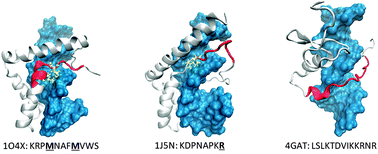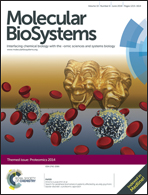Evolutionarily conserved and conformationally constrained short peptides might serve as DNA recognition elements in intrinsically disordered regions†
Abstract
Despite recent advances, it is yet not clear how intrinsically disordered regions in proteins recognize their targets without any defined structures. Short linear motifs had been proposed to mediate molecular recognition by disordered regions; however, the underlying structural prerequisite remains elusive. Moreover, the role of short linear motifs in DNA recognition has not been studied. We report a repertoire of short evolutionarily Conserved Recognition Elements (CoREs) in long intrinsically disordered regions, which have very distinct amino-acid propensities from those of known motifs, and exhibit a strong tendency to retain their three-dimensional conformations compared to adjacent regions. The majority of CoREs directly interact with the DNA in the available 3D structures, which is further supported by literature evidence, analyses of ΔΔG values of DNA-binding energies and threading-based prediction of DNA binding potential. CoREs were enriched in cancer-associated missense mutations, further strengthening their functional nature. Significant enrichment of glycines in CoREs and the preference of glycyl ϕ–Ψ values within the left-handed bridge range in the L-disallowed region of the Ramachandran plot suggest that Gly-to-nonGly mutations within CoREs might alter the backbone conformation and consequently the function, a hypothesis that we reconciled using available mutation data. We conclude that CoREs might serve as bait for DNA recognition by long disordered regions and that certain mutations in these peptides can disrupt their DNA binding potential and consequently the protein function. We further hypothesize that the preferred conformations of CoREs and of glycyl residues therein might play an important role in DNA binding. The highly ordered nature of CoREs hints at a therapeutic strategy to inhibit malicious molecular interactions using small molecules mimicking CoRE conformations.


 Please wait while we load your content...
Please wait while we load your content...